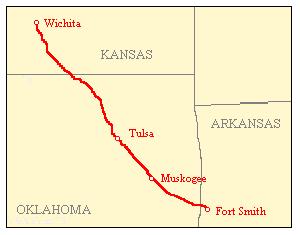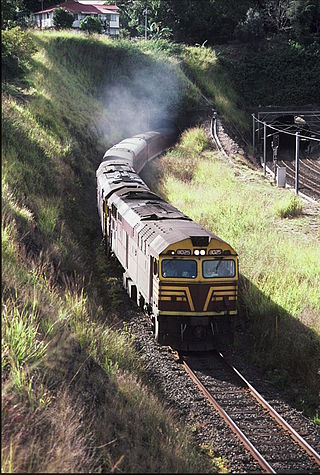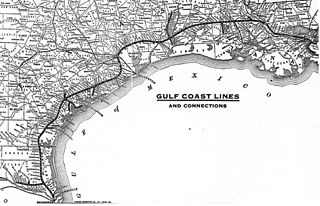
Blackwell is a city in Kay County, Oklahoma, United States, located at the intersection of U.S. Highway 177 and State Highway 11 along Interstate 35. The population was 7,092 at the 2010 census and 6,085 in the 2020 Census. Blackwell was established following the September 16, 1893 Cherokee Outlet land run by A. J. Blackwell. Blackwell has an agricultural and fossil fuel based economy.

The Missouri Pacific Railroad, commonly abbreviated as MoPac, was one of the first railroads in the United States west of the Mississippi River. MoPac was a Class I railroad growing from dozens of predecessors and mergers. In 1967, the railroad operated 9,041 miles of road and 13,318 miles of track, not including DK&S, NO&LC, T&P, and its subsidiaries C&EI and Missouri-Illinois.

Stouffville is one of the seven train lines of the GO Transit system in the Greater Toronto Area, Ontario, Canada. Its southern terminus is Union Station in Toronto, and its northern terminus is Old Elm in Whitchurch-Stouffville. There are connections from almost every station to Toronto Transit Commission or York Region Transit bus services.

The St. Louis–San Francisco Railway, commonly known as the "Frisco", was a railroad that operated in the Midwest and South Central United States from 1876 to April 17, 1980. At the end of 1970, it operated 4,547 miles (7,318 km) of road on 6,574 miles (10,580 km) of track, not including subsidiaries Quanah, Acme and Pacific Railway and the Alabama, Tennessee and Northern Railroad; that year, it reported 12,795 million ton-miles of revenue freight and no passengers. It was purchased and absorbed into the Burlington Northern Railroad in 1980. Despite its name, it never came close to San Francisco.

Farmrail System, Inc. is an employee-owned holding company for two Class III common-carrier railroads comprising "Western Oklahoma’s Regional Railroad" based in Clinton, Oklahoma. Farmrail Corporation (reporting mark FMRC) has acted since 1981 as a lessee-operator for Oklahoma Department of Transportation, managing an 82-mile east-west former Rock Island line between Weatherford and Erick and an additional 89 miles of former Santa Fe track, Westhorn-Elmer, acquired by the State in 1992 from the ATSF Railway. Another wholly owned affiliate, Grainbelt Corporation (GNBC), was formed in 1987 to buy 176 contiguous north-south route-miles linking Enid and Frederick.

The Kiamichi Railroad Company is a Class III short-line railroad headquartered in Hugo, Oklahoma.

The Midland Valley Railroad (MV) was a railroad company incorporated on June 4, 1903 for the purpose of building a line from Hope, Arkansas, through Muskogee and Tulsa, Oklahoma to Wichita, Kansas. It was backed by C. Jared Ingersoll, a Philadelphia industrialist who owned coal mining properties in Indian Territory. The railroad took its name from Midland, Arkansas, a coal mining town in western Arkansas, which was served by the railroad. The Midland Valley gained access to Fort Smith, Arkansas via trackage rights over the Frisco from Rock Island, Oklahoma.
The Oklahoma, Kansas and Texas Railroad (OKT) was a railroad operating in its namesake states in the 1980s.
The Arkansas, Oklahoma and Western Railroad (AO&W) was a small railroad company in Northwest Arkansas, United States.
The Arkansas Valley and Western Railway (AV&W) was built as a short line railroad operating within the U.S. state of Oklahoma. It was founded in 1902 to link the city of Tulsa with the main transcontinental line of the Atchison, Topeka and Santa Fe Railway (AT&SF) at Avard. The line was built in sections, initially from AV&W Jct. to Steen (Enid) during 1902-03. In 1904 it was extended westward to the junction with AT&SF at Avard. On July 19, 1907, the railroad was purchased by the St. Louis-San Francisco Railway, who operated it until November 21, 1980, when the Frisco was acquired by Burlington Northern Railroad.
The Denver, Enid and Gulf Railroad (DE&G) was built as a short line railroad operating in Kansas, and Oklahoma. Incorporated in Oklahoma as the Denver, Enid and Gulf Railroad Company, March 31, 1902, by the five Frantz Brothers.

The Sydney–Brisbane railway corridor is a 1,008.25 kilometres (626.50 mi) long standard-gauge railway corridor that connects the state capitals of Brisbane (Queensland) and Sydney in Australia.
The Choctaw, Oklahoma and Gulf Railroad (CO&G), known informally as the "Choctaw Route," was an American railroad in the states of Arkansas and Oklahoma.

The Gulf Coast Lines was the name of a railroad system comprising three principal railroads, as well as some smaller ones, that stretched from New Orleans, Louisiana, via Baton Rouge and Houston to Brownsville, Texas. Originally chartered as subsidiaries of the Frisco Railroad, the system became independent in 1916 and was purchased by the Missouri Pacific Railroad in 1925.

The Frisco Depot in Fayetteville, Arkansas, is a railroad depot built in 1925. The last passenger trains left Frisco Depot in 1965, and starting in 2011, the depot's interior houses a Chipotle Mexican Grill. The property was listed on the National Register of Historic Places on December 8, 1988.
The St. Louis, San Francisco and Texas Railway was a subsidiary railway to the St. Louis-San Francisco Railway (Frisco) operating 159 miles of railway line in Texas. The Frisco, including the subsidiary, formed a large X-shaped system across the states of Kansas, Missouri, Oklahoma, Texas, Arkansas, Mississippi and Alabama. It merged into SLSF at the beginning of 1964; SLSF merged into the Burlington Northern Railroad in 1980.
The Texas and Oklahoma Railroad (TXOR), created in 1991, ran between Oklahoma and Texas on rail purchased from the Atchison, Topeka and Santa Fe Railway (AT&SF). Much of the trackage has since been sold or abandoned; however, the railway continues to exist as a shortline carrier operating between Sweetwater, Texas and Maryneal, Texas.
The Ozark and Cherokee Central Railway (O&CC) was formed under the name of the North Arkansas & Western Railway in 1899. At its maximum, it owned a standard gauge, single track line running between Fayetteville, Arkansas and Okmulgee, Oklahoma. Its assets were merged into the St. Louis and San Francisco Railway (Frisco) in 1907.
The St. Louis, San Francisco and New Orleans Railroad ran from Hope, Arkansas to a point near Ardmore, Oklahoma, and encompassed about 219 miles of track including a branch line. It existed from 1895 to 1907, when its assets were taken over by the St. Louis-San Francisco Railway (“Frisco”).








